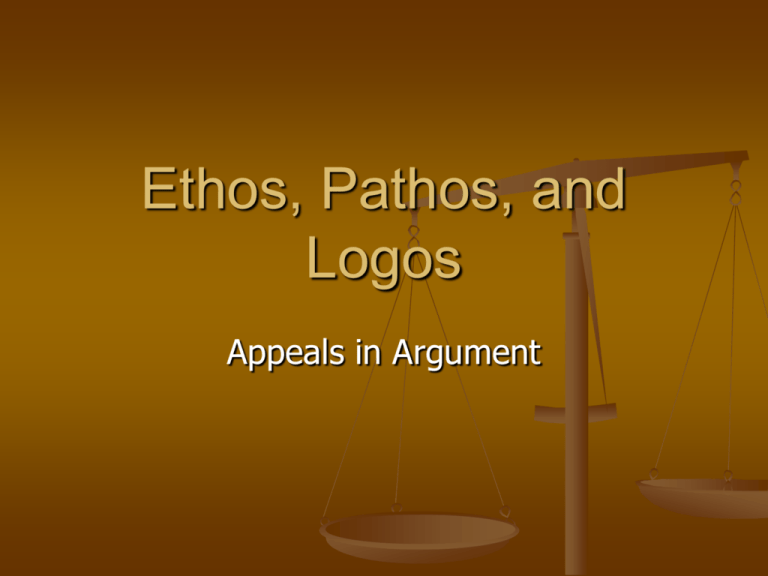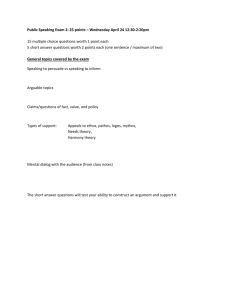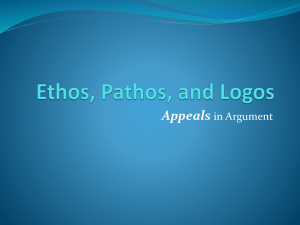Ethos, Pathos, and Logos
advertisement

Ethos, Pathos, and Logos Appeals in Argument Persuasive writing The goal of argumentative/persuasive writing is to persuade your audience that your ideas are valid, or more valid than someone else's. The Greek philosopher Aristotle divided the means of persuasion, appeals, into three categories--Ethos, Pathos, Logos. Aristotle taught there are 3 main strategies in an argument Logos/Logical Ethos/Credibility Pathos/Emotional Rhetorical Chart Author’s Purpose Logos Ethos Pathos The core of the rhetorical chart is purpose—What does the author/speaker cartoonist/filmmaker/advertiser want the reader/listener/viewer to Feel? Think? Do? Ethos: Ethical Appeals the source's credibility, the speaker's/author's authority How well an author/speaker presents him/herself Questions for considering a writer’s ethos: Does he or she seem knowledgeable? Reasonable? Trustworthy? Does he or she treat their opponents with fairness and respect or do they take cheap shots? Does he or she try and establish common ground with the reader/audience? Ethos-Credibility Appeals to the conscience, ethics, morals, standards, values, and principles. Author or speaker tries to convince you he is of good character. Qualified to make his claims. Cites relevant authorities. Quotes others accurately and fairly. Examples of Ethos "If, in my low moments, in word, deed or attitude, through some error of temper, taste, or tone, I have caused anyone discomfort, created pain, or revived someone's fears, that was not my truest self. If there were occasions when my grape turned into a raisin and my joy bell lost its resonance, please forgive me. Charge it to my head and not to my heart. My head--so limited in its finitude; my heart, which is boundless in its love for the human family. I am not a perfect servant. I am a public servant doing my best against the odds." (Jesse Jackson, Democratic National Convention Keynote Address, 1984) Political Cartoon Ethos Pathos: Emotional Appeals the emotional or motivational appeals; vivid language, emotional language and numerous sensory details. How well the author taps into the audiences emotions Questions for considering a writer’s pathos: Does the topic matter to the audience? Does the writer include anecdotes? Does the writer appeal to your emotions, memories, fears, etc.? Is the emotional appeal effective or overwhelming? Is the writing overloaded with facts and figures? Pathos-Emotional Appeal Appeals to the heart, Emotions, Sympathy, Passions, Sentimentality, Uses imagery, figurative language, Carefully constructed sentences. Example of Pathos Logos: Logical Appeal the logic used to support a claim; can also be the facts and statistics used to help support the argument. How well the author uses text and evidence to support own argument or claims. Should be well organized. Questions for considering a text’s logos: What is being argued or what is the author’s thesis? What points does the author offer to support their thesis? Are ideas presented logically? LOGOS-Logical Argument Involves facts or Research Quoted authorities Cause and Effect information Analogies or comparisons Common sense information Shared values Precedents Example of Logos





